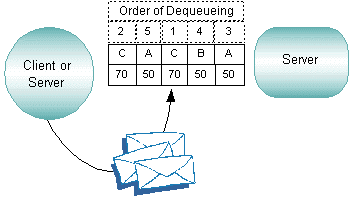


|

|
|
|
|
What Is Message Prioritization?
Priorities determine the order in which service requests are dequeued by a server. Priority is assigned by a client to individual services and can range from 1 to100, where 100 represents the highest priority.
All services are assigned a starting priority of 50. A server's starting priority can be changed during application configuration. Once you have defined your set of services, you can assign the appropriate priorities to them. For example, your business may require that some services have a relatively high priority of 70, which means those services are dequeued before those with the lower priority of 50. In the following illustration, a server offers services A (with a priority of 50), B (with a priority of 50), and C (with a priority of 70).
Prioritization of Messages
A request for service C is always dequeued before a request for A or B due to the higher priority of C. Requests for A and B have equal priority. This feature is useful in applications in which not all requests are equally urgent or important. A "starvation prevention" mechanism prevents low-priority messages from waiting endlessly on the queue. Every tenth message is dequeued in FIFO (first in first out) order regardless of priority; the first through the ninth messages are dequeued in order of priority.

|

|

|
|
|
|
Copyright © 2001 BEA Systems, Inc. All rights reserved.
|